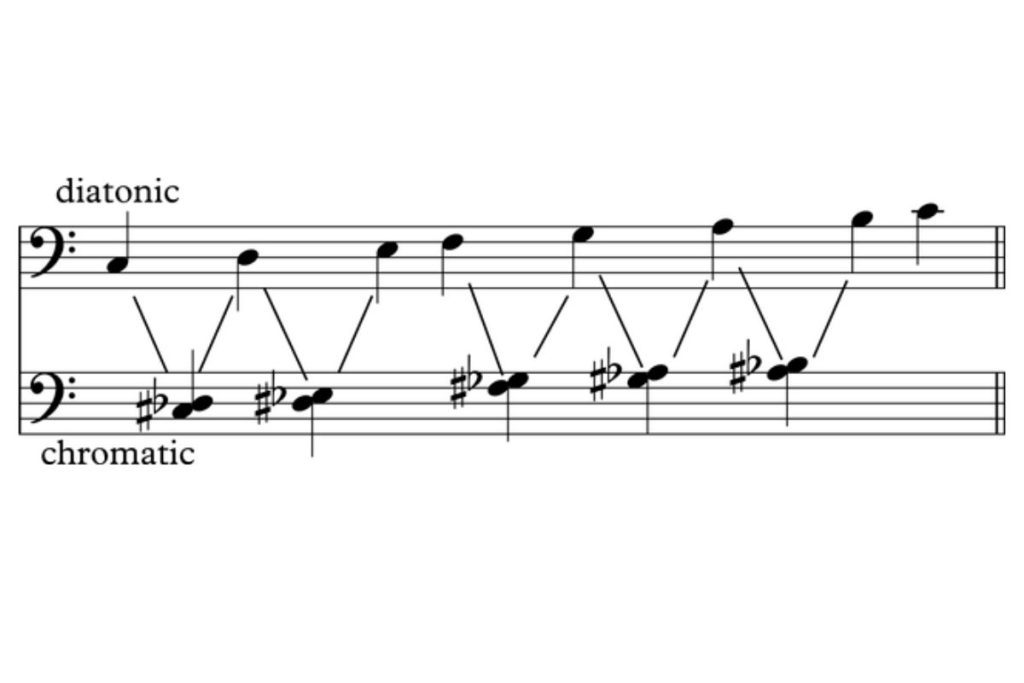Are you ready to unravel the musical mystery of diatonic scales? Prepare to dive into a world of seven tones, captivating melodies, and the secrets behind those catchy tunes. Can you hear the diatonic magic? In this blog post, we will delve into the meaning of diatonic and its significance in understanding the structure and tonality of music. Let’s dive into the enchanting world of diatonic and uncover its hidden wonders!
What does diatonic mean? Diatonic refers to a type of musical scale that encompasses seven tones per octave, creating a harmonious sequence of notes that form the foundation of countless melodies.
What makes up a diatonic scale?
A diatonic scale is made up of seven unique pitches or notes within an octave. These notes follow a specific pattern of whole steps and half steps, also known as intervals. The pattern for a major diatonic scale is whole, whole, half, whole, whole, whole, half. Each note in the scale has a distinct relationship with the tonic or the first note of the scale, creating a sense of tonal center.

The diatonic scale forms the foundation for much Western music and is widely used in various genres and compositions. Its predictable and harmonically pleasing structure makes it a vital tool for composers, songwriters, and musicians alike.
Tones and half steps
There are five tones, also known as whole steps, that create a sense of musical expansiveness and different pitches. We have the two half steps, or semitones, adding a touch of tension and creating some intriguing musical flavors. These half steps are the shortest musical intervals we encounter in Western music. They are like little musical surprises hidden in the scale, just waiting to captivate our ears.
Letter names and diatonic chords
In diatonic scales, there are seven letter names or notes in a specific sequence. It’s like having a musical alphabet that we string together to form melodies and harmonies. Chords built from these seven notes in each key are called diatonic chords.
AKAI Professional MPK Mini MK3

AKAI Professional MPK Mini MK3
What are the types of diatonic scales?
There are many diatonic scales, not just one!
One of the characteristics of a diatonic scale is the presence of two semitones (half steps) and five tones (full steps), with the semitones separated by three tones.
Major scale
The major scale is the most well-known and easily recognized of all diatonic scales. If you play all the white notes on a piano keyboard beginning with C, you will play a major scale and a diatonic scale.
You can then transpose this sequence to begin on any note. As long as the order of semitones and tones is constant, you’ll have played a major scale, which is a diatonic scale.
Natural minor scale
A minor scale accompanies every major scale. The notes of the relative major and minor scales are the same, although they begin at different pitches. This implies they have a different tonal and semitone sequence, but the space between the semitones is still three tones.
Mode scale
The musical modes are a collection of scales based on the major scale that have distinct qualities.
Each mode begins at a distinct major scale degree.
- Ionian mode, first degree
- Dorian mode, second degree
- Phrygian mode, third degree
- Lydian mode, fourth degree
- Mixolydian mode, fifth-degree
- Aeolian mode, sixth degree
- Locrian mode, seventh degree
Here’s a table of “dos and don’ts” when working with diatonic scales.
| Dos | Don’ts |
|---|---|
| Experiment with different keys and modes | Limit yourself to one key or mode |
| Combine diatonic scales with other musical elements | Overuse diatonic progressions |
| Use transposition to explore different tonalities | Neglect the emotional impact of different modes |
| Apply diatonic chord progressions to enhance your compositions | Disregard the role of tension and resolution in diatonic scales |
Although each mode begins on a different note of the scale and has a distinct tonic note, they are all diatonic scales with shifted semitones and tones. By integrating diatonic scales into your compositions, you can create harmonies that effortlessly blend together and melodies that captivate listeners’ ears.

How do diatonic and chromatic scales differ?
Diatonic and chromatic scales are like two sides of a coin, each with its unique characteristics. Let’s unravel the key differences between these two scales and understand their impact on music:
The diatonic scale
The diatonic scale, as we’ve learned, is a sequence of seven notes per octave. It follows a specific pattern of whole and half steps, creating harmonious melodies that resonate with our ears and souls. Diatonic scales are like the backbone of music theory, providing the foundation for countless compositions throughout history. They offer a sense of stability, musicality, and a familiar tonal framework that we can easily grasp.
The chromatic scale
Unlike the diatonic scale’s seven-note structure, the chromatic scale is a full-blown extravaganza, encompassing all twelve pitches or note tones within an octave. The chromatic scale consists of consecutive half steps, creating a sense of constant tension and dissonance.
The diatonic scale primarily uses the white keys, whereas the chromatic scale embraces both the white and black keys.
To visualize the difference, think of a piano keyboard. The diatonic scale primarily uses the white keys, whereas the chromatic scale embraces both the white and black keys. Musicians tap into the full spectrum of pitches when playing chromatic notes, adding color, flavor, and a touch of musical adventure to their compositions. The chromatic scale brings a sense of richness and complexity, challenging traditional tonal boundaries.
Diatonic scales provide a solid foundation, creating tonal frameworks and facilitating melodic and harmonic coherence. They are like a trusted friend, offering familiarity and stability. On the other hand, chromatic scales add spice, drama, and a touch of unpredictability. They are the rebels of the musical realm, pushing boundaries and igniting creativity.
Here’s a table outlining the main differences between diatonic and chromatic music:
| Aspect | Diatonic | Chromatic |
|---|---|---|
| Scale Structure | Consists of seven unique notes within an octave | Includes all twelve notes within an octave |
| Interval Pattern | Follows a specific pattern of whole steps and half steps | No predetermined interval pattern |
| Tonal Center | Has a clear tonal center or key | Does not have a specific tonal center or key |
| Musical Use | Forms the foundation of most Western music | Used to create tension, dissonance, or expressive effects |
| Harmonic Function | Often used for melodic lines, chords, and harmonies | Utilized for chromaticism, modulation, and coloration |
What are the advantages and disadvantages of using diatonic scales?
When it comes to incorporating diatonic scales in music production, there are distinct advantages and disadvantages to consider. Let’s explore how diatonic scales can enhance your musical creations, as well as the potential challenges they may present.
Advantages
Using diatonic scales in music production offers several benefits:
- Enhanced musicality: Diatonic scales provide a sense of cohesion and musicality to compositions, making them pleasing to the ears.
- Ease of use: Diatonic scales follow well-established patterns, making them relatively easy to understand, use, and apply in various musical contexts.
- Melodic and harmonic stability: Diatonic scales form the foundation for melodic and harmonic stability, allowing for memorable melodies and compelling chord progressions.
- Compatibility with western music: Diatonic scales are deeply ingrained in Western music traditions, making them familiar and accessible to a wide range of listeners.
- Versatility: Diatonic scales can be transposed to different keys, allowing for versatility and exploration of different tonalities.
Disadvantages
While diatonic scales offer numerous advantages, there are some potential disadvantages to be aware of:
- Limited tonal palette: Strict adherence to diatonic scales may limit the use of chromaticism and unconventional harmonic choices, potentially resulting in a less adventurous or experimental sound.
- Predictability: Diatonic scales can become predictable if overused without incorporating other musical elements, potentially leading to compositions that lack uniqueness or surprise.
- Challenges with non-western music: Diatonic scales are primarily rooted in Western music traditions, which may present challenges when working with non-Western musical styles that utilize different tonal systems.
It’s important to strike a balance between the advantages and disadvantages of using diatonic scales, allowing for both familiarity and creative exploration in your musical productions.
If you want even more great tips and information, check out the video.
Frequently Asked Questions (FAQ)
Let’s address some common questions that may be lingering in your mind about diatonic scales and their role in music production.
Can I use diatonic scales in genres other than classical or jazz?
Absolutely! Diatonic scales are incredibly versatile and can be applied to a wide range of musical genres. While they have roots in classical and jazz music, diatonic scales can be adapted and integrated into various styles, including pop, rock, hip-hop, and electronic music.
They provide a strong foundation for melodic and harmonic elements in any genre, allowing you to create captivating compositions regardless of your musical preference.
Are diatonic scales limited to major and minor keys?
While major and minor keys are the most commonly used diatonic scales, they are not the only options. Diatonic scales can be explored in different modes, such as Dorian, Phrygian, Lydian, Mixolydian, Aeolian, and Locrian. Each mode offers its unique characteristics and emotional qualities, expanding your tonal palette and providing a diverse range of musical possibilities.
So, don’t hesitate to venture beyond the major and minor keys and explore the captivating world of diatonic modes.
Can I use chromatic notes within diatonic scales?
Certainly! While diatonic scales primarily consist of seven distinct notes, there is room for incorporating chromaticism within them. Chromatic notes can be used as passing tones or to add color and tension to your compositions. When used tastefully, chromatic notes can create interesting melodic and harmonic nuances, adding depth and expression to your music.
Conclusion
And there you have it, folks! We’ve journeyed through the enchanting realm of diatonic scales, uncovering their significance in music production. From understanding the structure of diatonic scales and exploring their modes to harnessing their power in composition and arrangement, you’re now equipped with the knowledge to create harmonious musical experiences.
Let me know your questions in the comments section below (I read and reply to every comment). If you found this article helpful, share it with a friend, and check out my full blog for more tips and tricks on diatonic scales and other music-related topics. Thanks for reading, and keep on grooving to the rhythm of your creativity!
Key takeaways
This article covered the topic of diatonic scales in music production. Here are some key takeaways:
- Diatonic scales consist of seven notes per octave and serve as a foundation for melodic and harmonic elements.
- They can be used in various genres beyond classical and jazz, including pop, rock, hip-hop, and electronic music.
- Diatonic scales include modes such as Dorian, Phrygian, Lydian, Mixolydian, Aeolian, and Locrian, each with its unique qualities.
- Chromatic notes can be incorporated within diatonic scales to add color and tension to compositions.
- Embrace the power of diatonic scales to unleash your creativity and create captivating musical experiences.















